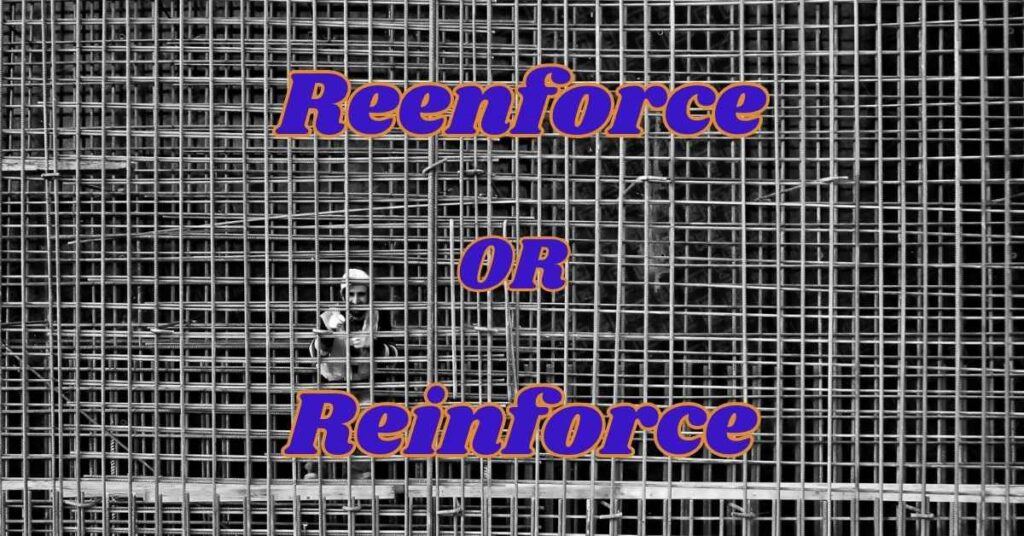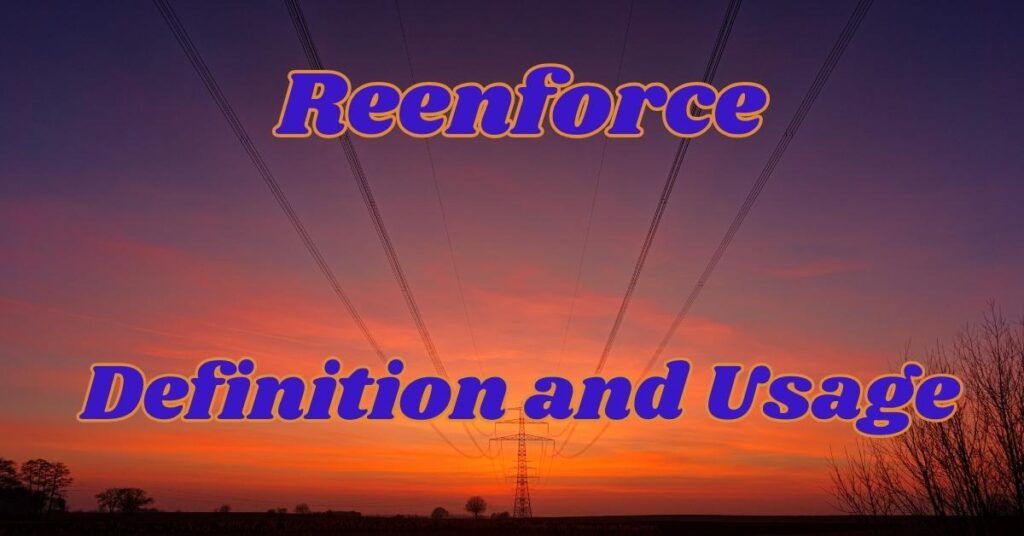Reenforce vs Reinforce is a common point of confusion for many writers. Understanding the difference between these two terms is essential for clear and effective communication, especially in academic and professional writing.
While “reinforce” is the correct spelling and widely accepted in English, “reenforce” is simply a misspelling that lacks recognition in standard usage. This article will clarify the meanings, origins, and proper applications of both terms.
By the end, you will know how to use “reinforce” accurately in your writing, avoiding common mistakes that can undermine your credibility and clarity. Let’s dive into this simple guide to enhance your understanding
Quick Summary
In this article, we will explore the differences between “reinforce” and “reenforce.” While “reinforce” is the correct spelling and widely accepted in English, “reenforce” is considered a misspelling. We will delve into the definitions, usage, and historical backgrounds of both terms to help you avoid common mistakes in your writing.
Understanding Reenforce vs Reinforce

The word “reinforce” means to strengthen or support something, whether it be an idea, a structure, or a behavior. For example, in educational settings, teachers often use reinforcement techniques to encourage positive behaviors among students.
On the other hand, “reenforce” does not have an accepted definition in standard English; it is simply a misspelling of “reinforce.” This misunderstanding often arises from phonetic similarities and can lead to confusion in written communication.
Is Reenforce a Misspelling of Reinforce?
Yes, “reenforce” is indeed a misspelling of “reinforce.” Many people mistakenly use this term due to its similarity in sound. The error usually occurs when individuals are unsure of the correct spelling or when they type quickly without proofreading their work.
This common mistake can detract from the professionalism of academic writing or any formal communication.
Why Reinforce is the Preferred Spelling
The preferred spelling, “reinforce,” is essential for clear communication. Using the correct spelling enhances your credibility as a writer and ensures that your audience understands your message without confusion.
In academic contexts, where precision is crucial, sticking to standard spellings like “reinforce” helps maintain clarity and professionalism.
Origins of the Reenforce
The term “reenforce” has no significant historical background or recognized etymology in English literature. It appears mainly as a result of typographical errors or misunderstandings. Unlike its counterpart, which has a well-documented history, “reenforce” lacks legitimacy in formal writing.
Does “Reenforce” Have Historical Significance?
Since “reenforce” is not recognized as a standard word in English, it does not carry any historical significance. It may appear occasionally in informal contexts or as a typo but does not have an established role in language development or evolution.
Origins of the Reinforce
“Reinforce” originated around the early 1600s, initially used in a military context to mean “add new force, strength, or weight.” It combines the prefix “re-“, meaning “again,” with “inforce,” a variant of “enforce,” which means to strengthen.
Over time, the ordinary form has evolved, and “reinforce” is now commonly used in various contexts beyond its original military meaning.
The Latin Roots of “Reinforce”
“Reinforce” derives from the Latin roots “re-“, meaning “again,” and “inforce,” which relates to making something stronger. This combination highlights the concept of strengthening something anew.
Unlike “reenforce,” which lacks historical significance, “reinforce” has a well-documented lineage that emphasizes its importance in the English language.
Reenforce: Definition and Usage

“Reenforce” is often mistakenly used in place of “reinforce.” However, it does not have an accepted definition in standard English. Writers should avoid using “reenforce,” as it is considered a misspelling.
Instead, focus on the correct term, “reinforce,” which means to strengthen or support something. Understanding this distinction is crucial for effective communication.
Reenforce Definition
“Feenforce” lacks a formal definition in reputable dictionaries. It appears primarily as a typographical error or misunderstanding of the correct term “reinforce.” Therefore, it’s essential to remember that using “reenforce” in writing can lead to confusion and diminish clarity.
Does “Reenforce” Have a Definition?
No, “reenforce” does not have a recognized definition in standard English usage. It is not included in major dictionaries, making it clear that this term should be avoided in both academic and professional writing.
Writers should always opt for the correct spelling, “reinforce,” to ensure their message is understood without ambiguity.
Reinforce: Definition and Usage

“Reinforce” is widely used in various contexts, meaning to strengthen or support something. This can apply to ideas, structures, or behaviors. Understanding its definition is essential for clear communication, especially in academic and professional settings.
By using “reinforce” correctly, writers can convey their messages more effectively and avoid confusion that may arise from misspellings or misunderstandings.
Reinforce Definition
“Reinforce” means to make something stronger or more effective. In practical terms, it can refer to adding support to a physical structure, like reinforcing a wall with steel beams. In a broader sense, it can also mean strengthening an argument or idea by providing additional evidence or support, enhancing its overall impact.
What Does Reinforce Mean in Education and Psychology?
In education, “reinforce” refers to strategies used by teachers to encourage positive behaviors among students. For example, rewarding good performance with praise is a form of positive reinforcement.
In psychology, reinforcement plays a crucial role in behavior modification, helping individuals learn new behaviors through rewards or consequences that strengthen desired actions.
The Adjective Form of Reinforce
The adjective form of “reinforce” is “reinforced.” This term describes something that has been made stronger or more secure through additional support.
For instance, reinforced materials like concrete are essential in construction to ensure stability and safety. Using the adjective correctly helps convey the concept of strength in various contexts.
What is the Noun Form of Reinforce?
The noun form associated with “reinforce” is “reinforcement.” This term refers to the act of strengthening something or the additional support provided.
In educational psychology, reinforcement techniques are vital for shaping behavior by encouraging desired actions through rewards or consequences. Understanding this noun form enhances clarity when discussing related concepts.
Reinforce Usage
“Reinforce” is commonly used across various contexts, including education, psychology, and construction. Its primary meaning is to strengthen or support something, whether it’s an idea, a behavior, or a physical structure.
Understanding how to use “reinforce” correctly allows writers and speakers to communicate more effectively. By employing this term appropriately, one can enhance clarity and ensure that their message resonates with the audience.
Usage of Reinforce in Modern English

“Reinforce” appears frequently in both spoken and written communication. People use it to describe actions that strengthen arguments, support ideas, or enhance physical structures.
For example, in discussions about teamwork, someone might say, “We need to reinforce our strategy with data.” This usage highlights the term’s versatility and importance in conveying clear messages.
How “Reinforce” is Used in Everyday Language
“Reinforce” is often used to express the idea of strengthening a point or action. For instance, someone might say, “I want to reinforce my commitment to this project.”
This shows how the term can apply to personal promises or professional obligations. Using “reinforce” in casual conversation helps convey seriousness and determination.
Verb Forms of Reinforce
The verb “reinforce” has several forms that are useful in different contexts. The present participle form is “reinforcing,” which describes an ongoing action. The past tense is “reinforced,” indicating that the action has already occurred. Understanding these forms allows for greater flexibility in writing and speaking while maintaining grammatical accuracy.
How to Use “Reinforce” in Verb Forms
Use “reinforce” correctly in verb forms, consider the context of your sentence. For example, you might say, “We will reinforce our findings during the presentation,” using the base form.
In contrast, you could say, “The team reinforced their strategy last week,” showcasing the past tense. This flexibility helps convey precise meanings based on timing and context.
Synonyms of Reinforce
Here are Synonyms for “reinforce”:
- Strengthen
- Support
- Bolster
- Enhance
- Fortify
- Augment
- Amplify
- Confirm
- Validate
- Buttress
These synonyms can add variety and depth to your writing while maintaining clarity.
Side by Side Comparison
| Aspect | Reinforce | Reenforce |
| Definition | To strengthen or support something | No accepted definition; considered a misspelling |
| Usage | Commonly used in education, psychology, and construction | Rarely used; often appears as a typo |
| Etymology | Derived from Latin roots “re-” (again) and “fortis” (strong) | Lacks historical significance |
| Forms | Verb: reinforce, Present Participle: reinforcing, Past Tense: reinforced | No recognized forms |
| Context of Use | Used in formal and informal writing | Not suitable for formal or academic writing |
| Common Mistakes | Misused as “reenforce” due to phonetic similarity | Often confused with the correct spelling |
Everyday Usage Examples

Understanding how to use “reinforce” and its misspelled counterpart “reenforce” in everyday language is crucial for effective communication. While “reinforce” is the correct term, many people mistakenly use “reenforce.”
This section will provide clear examples of each term in context. By examining these examples, you can better grasp how to apply “reinforce” accurately in your conversations and writing, ensuring clarity and professionalism.
Reenforce Example
An incorrect usage of “reenforce” might be: “I plan to reenforce my argument with more facts.” In this sentence, the writer intended to use “reinforce,” but the misspelling creates confusion. It’s important to proofread your work to avoid such errors, as they can undermine the credibility of your message.
Reinforce Example
A correct usage of “reinforce” would be: “The teacher used positive feedback to reinforce good behavior in the classroom.” This sentence clearly illustrates how “reinforce” can be applied in an educational context.
By using the term correctly, the writer effectively communicates the idea of strengthening positive actions through supportive measures.
Examples of Reinforce in Sentences
Using “reinforce” correctly in sentences is essential for clear communication across various contexts. This term can apply to education, construction, psychology, and even everyday conversations.
By providing specific examples, we can see how “reinforce” enhances meaning and clarity. Understanding these examples helps writers and speakers use the term effectively, ensuring their messages are understood without confusion. Below are examples of how “reinforce” is used in different contexts.
Educational Context
- Teachers often use praise to reinforce students’ positive behaviors.
- Assignments that include feedback help reinforce learning objectives.
- Group activities can reinforce teamwork skills among students.
Construction and Engineering
- Engineers must reinforce structures with steel beams for safety.
- Builders often use concrete to reinforce foundations against earthquakes.
- Proper design can help reinforce the durability of a building.
Psychological Reinforcement
- Therapists use rewards to reinforce desired behaviors in clients.
- Positive reinforcement strategies can help reinforce good habits.
- Behavior modification techniques often rely on reinforcement principles.
Reinforcing Communication
- Regular feedback sessions help reinforce clear communication within teams.
- Managers should reinforce expectations to improve team performance.
- Using data can reinforce arguments during presentations.
The Role of Reinforce in Performance Management

The concept of “reinforce” plays a critical role in shaping employee behavior and enhancing productivity. By providing regular feedback and recognition, managers can reinforce positive actions and outcomes within their teams.
This approach not only motivates employees but also fosters a culture of accountability and continuous improvement. Understanding how to effectively use reinforcement strategies can lead to better team dynamics and overall organizational success.
How Reinforcement Improves Team Performance
Reinforcement improves team performance by encouraging desired behaviors through positive feedback and rewards. When team members receive recognition for their contributions, they feel valued and motivated to maintain high standards.
Additionally, reinforcement helps clarify expectations, allowing individuals to understand what actions lead to success. By consistently applying reinforcement techniques, organizations can create an environment where employees are engaged, productive, and committed to achieving team goals.
The Correct Spelling: Reinforce vs Reenforce
Understanding the correct spelling between “reinforce” or “reenforce” is crucial for effective communication. The term “reinforce” is the standard spelling, meaning to strengthen or support something.
In contrast, “reenforce” is a misspelling that lacks recognition in formal English. Using the correct term not only enhances clarity but also reflects professionalism in writing.
This section will explore how to spell “reinforce” correctly, why “reenforce” is rarely used, and common spelling rules to avoid mistakes.
How to Spell “Reenforce” Correctly
To spell “reinforce” correctly, remember that it begins with “re-” and includes “inforce.” This term combines the prefix “re-” meaning “again,” with “inforce,” which relates to strength or support.
Always double-check your writing to ensure you use the correct spelling, as this small detail can significantly impact your message’s clarity and professionalism.
Why “Reenforce” is Not Commonly Used
“Reenforce” is not commonly used because it does not have an accepted definition in standard English. It often appears as a typographical error or misunderstanding of the correct term “reinforce.” Since “reenforce” lacks recognition in reputable dictionaries, writers should avoid using it to maintain clarity and professionalism in their communication.
Spelling Rules and Common Mistakes
Common mistakes related to the spelling of “reinforce” often arise from phonetic similarities with other words. To avoid these errors, familiarize yourself with common prefixes like “re-.”
Additionally, proofreading your work can help catch any typos or misspellings before finalizing your writing. Understanding these rules will enhance your overall writing accuracy and effectiveness.
Reinforce vs Reenforce Grammar

Understanding the grammatical differences between “reinforce” and “reenforce” is essential for clear communication. The correct term, “reinforce,” is a verb that means to strengthen or support something.
In contrast, “reenforce” is a misspelling and does not have a recognized grammatical form. Using the correct spelling ensures that your writing is professional and free from confusion. This section will highlight common grammar mistakes associated with these terms to help you avoid errors in your writing.
Common Grammar Mistakes to Avoid
- Using “reenforce” instead of “reinforce,” which can confuse readers.
- Incorrect verb forms, such as saying “reenforced” instead of “reinforced.”
- Mixing up the noun form “reinforcement” with the misspelled version.
- Failing to double-check your writing for these common errors.
- Not ensuring consistent use of the correct term throughout your writing.
You May Also Like: Country’s or Countries: Which One is Correct?
FAQs: Reenforce vs Reinforce
Is reenforce a word?
No, “reenforce” is not recognized as a standard word in English; it is considered a misspelling of “reinforce.”
Why is it reinforce not reenforce?
The correct term is “reinforce,” meaning to strengthen or support, while “reenforce” lacks a proper definition and is not widely accepted.
What word can I use instead of reinforce?
Synonyms for “reinforce” include strengthen, support, bolster, and enhance.
What is a word for strengthen or reinforce?
A word that means to strengthen or reinforce is “fortify,” which conveys the idea of making something stronger.
What is reinforce in education?
In education, “reinforce” refers to strategies used by teachers to encourage positive behaviors and learning outcomes through rewards and feedback.
Conclusion
Understanding the difference between “reenforce” vs”reinforce” is crucial for effective communication. While “reinforce” is the correct term that means to strengthen or support, “reenforce” is simply a misspelling that can lead to confusion.
By using “reinforce” accurately in both writing and conversation, you enhance clarity and professionalism. Avoiding common mistakes will ensure that your message resonates with your audience. Remember, mastering the correct spelling and usage of “reinforce or reenforce” can significantly improve your communication skills.
Realated posts: Paradox vs Juxtaposition: Key Differences You Need to Know

